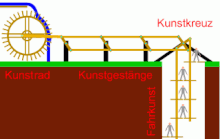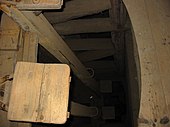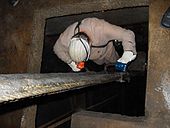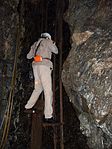Driving skills
For a long time, the art of driving was used for vertical passenger transport ( driving ) in a mine shaft . It is part of the diverse mining art .
In this case, was usually of at one, hydroelectric power , rotating wheel driven eccentrically secured a rod which translate the rotary motion into an oscillating longitudinal movement: the art linkage . This rod operated the artificial cross (a kind of seesaw), at the ends of which two long rods or ladder-like devices were attached that protruded down into the shaft. The artificial cross ensured that when the wheel turned, first one rod in the shaft rose while the other lowered. After half a turn of the wheel, the movement of the rods was reversed; now the first fell and the second rose. By changing between the two rods every half a turn of the wheel, the miner could either drive into or out of the shaft. The construction with two pairs of wire cables also existed.
history
initial situation
The mines of the Upper Harz mining industry had reached depths of 500 to 600 meters by 1800 . At that time it was the deepest mines in the world. For the miners, however, driving in and out on the journeys (= ladders) was an imposition: Under these conditions, a miner needed one hour to enter and two hours to exit. The latter was also an extraordinary physical exertion. Only the time on site was paid for. There were considerations, in some cases also requests, to allow the miners to spend the night underground in order to save them the frequent and stressful driving in and out. Obviously, this was only practiced in exceptional cases.
At the time, rope travel was not an alternative for the miners: On the one hand, there were no reliable ropes that would have allowed people to move safely. On the other hand, the conveyor systems of that time would not have had the capacity to convey a large number of miners at the beginning and end of the shift. Only injured or dead miners were brought to light with the mining bucket or the disabled.
invention
To drive the piston pumps for swamping the mines, there were already wooden rods in the shafts, which were constantly moving up and down. According to reports, the chief miner Georg Ludwig Dörell in Clausthal is said to have observed that a handyman Lichtenberg had hammered nails into these wooden rods to make his own work easier, in order to get there by skillfully changing from one work level to the next. Dörell, who is considered to be the inventor of the art of driving, continued to implement this idea in 1833 by equipping the poles with sturdy running boards and handles. This invention spread very quickly not only in German countries, but also in international mining (including Norway and England ).
meaning
In view of the previously extremely strenuous and lengthy driving in and out, the art of driving meant a great deal of relief in the mid-19th century: You could climb about 100 meters in altitude in five minutes without great physical exertion. This freed up forces to go deeper into ore mining. The longest driving skills reached depths of around 800 meters.
Until the end of the 19th century, the art of driving remained the essential facility for vertical passenger transport in the mines. It was only with the development of the wire rope that modern mines of the late 19th century were able to set up passenger transport by cable car. In the Kaiser-Wilhelm-Schacht (Clausthal) a rope conveyor was already set up in 1880, but there was still a driving skill with a distance of 8.0 meters from the stage for passenger conveyance. Obviously, the miners distrust a rope for a long time. It was not until 1920 that this art of driving was dismantled and replaced by rope travel.
Annotation:
- ↑ The distance between the platforms is the vertical distance between the running boards. The lifting height is half of the platform distance.
particularities
A disadvantage of driving skills was that it was not possible to meet miners entering and leaving. This had to be organized in some way. Presumably they agreed and waited for each other at certain intermediate levels (soles). On the other hand, individuals could easily switch back and forth between different levels (soles) during the shift, which in modern cable cars always requires requests and waiting for the cage. The vertical (saigere) driving art of the Kaiser Wilhelm shaft in Clausthal was provided with running boards on the front and back so that the miners could drive in and out at the same time. In addition to water wheels, water column machines , steam engines and later also electric motors served as drive .
Accidents
Driving with the art of driving was no more accident prone than using journeys (ladders); on the contrary. A study carried out in Belgian and English mines showed that only one fatal accident occurred out of 23,000,000 journeys .
In the Samson mine in St. Andreasberg there have been seven fatal accidents since the driving skills were first established in 1837. In the pit Rosenhof in 1878 broke the driving skills, 11 miners died.
The worst accident in Freiberg mining occurred in 1880 on the Abrahamschacht of the Ascension Treasure Trove , when the articulation of driving broke when the night shift came in and pulled all 13 miners on it with it into the depths. There were only two survivors, both of whom were severely damaged. During the subsequent examination it turned out that the poor condition of driving skills had caused the break. The reasons for this were neglected maintenance and repair work as well as the illegal use of the art above the Turmhof auxiliary tunnel. In the pursuit of the matter, the mine director Wengler and the art star Schmidt were sentenced to prison terms.
A serious accident occurred in the English copper mine in Levant on the afternoon of October 20, 1919. Over 100 miners were just doing the driving art when a metal clip at the top of the rod broke and the rod with the miners on it crashed. 31 miners were killed. The driving skills were then not repaired again.
Driving skills in the present
The last still functioning steel rope driving art (with two wire rope pairs) from 1837 can be viewed in the Samson mine in Sankt Andreasberg . It has a platform distance of 3.20 meters, now goes down to a depth of 190 meters and still serves the operator of the Samsonschacht hydroelectric power station, Harz Energie , as access to the turbines. A second art of driving with wooden poles is preserved in the Kongsberg silver mine ( Norway ), it is 25 m long and is only demonstrated in the museum. In the Upper Harz Mining Museum there are still original parts of a driving art from the Bockswies mining industry, but they are no longer functional.
The art of driving with wooden poles in the Norwegian Mining Museum in Kongsberg.
Driving art from the 19th century in the Upper Harz Mining Museum (view straight down)
literature
- Jens Pfeifer: The driving skills in Freiberg Revier with special consideration of the driving skill accident of February 29, 1880 on the Abraham shaft of the Assumption mine . In: Wolfgang Ingenhaeff, Johann Bair (Hrsg.): Proceedings 11th Montanhistorischer Kongress Schwaz, Hall in Tirol, Sterzing 2012. (= mining and art ). Volume III: Technical arts (water art, weather art, marrow art, conveyance art, driving art, melting art, etc.) . Berenkamp, Wattens 2013, p. 195–225 ( underground.com [PDF; 2.5 MB ; accessed on March 12, 2015]).
Individual evidence
- ↑ Meinecke: The "Kaiser Wilhelm II" shaft near Clausthal, machine technology part , special print from the magazine for the mining, metallurgy and saltworks in the Prussian state, Volume XLIII, for the VI. General German Miners' Day in Hanover, published by Wilhelm Ernst & Sohn, Berlin, 1895
- ↑ Jens Pfeifer: The driving skills in the Freiberg Revier with special consideration of the driving skill accident of February 29, 1880 on the Abraham shaft of the Ascension treasure trove. Lecture as part of the series studium generale , Reiche Zeche zu Freiberg, March 11, 2015
- ↑ Jens Pfeifer: The driving skills in the Freiberg Revier with special consideration of the driving skill accident of February 29, 1880 on the Abraham shaft of the Ascension treasure trove . In: Wolfgang Ingenhaeff, Johann Bair (Hrsg.): Proceedings 11th Montanhistorischer Kongress Schwaz, Hall in Tirol, Sterzing 2012. (= mining and art ). Volume III: Technical arts (water art, weather art, marrow art, conveyance art, driving art, melting art, etc.) . Berenkamp, Wattens 2013, p. 202–209 ( underground.com [PDF; 2.5 MB ; accessed on March 12, 2015]).
- ↑ Article by the BBC including an interview with contemporary witnesses from the 1960s .
Web links
- Thomas Krassmann: Driving skills - from the Harz to the world. (PDF; 1.6 MB) A mining historical contribution to the history and dissemination of driving skills. 2010, accessed March 12, 2015 .
- How does a sweeper actually work? Function of a sweeper bike (promotion & driving skills)
- Driving skills in the Samson Galileo mine Reportage on Pro 7
- Driving skills in the Samson mine (NDR media library / Lower Saxony 19:30)






